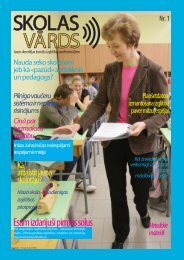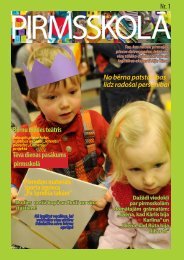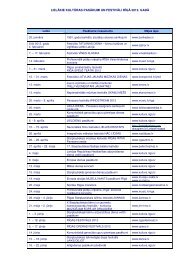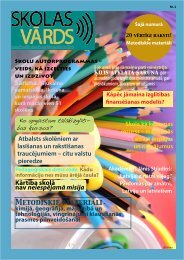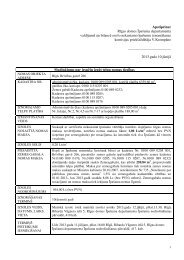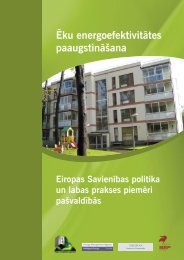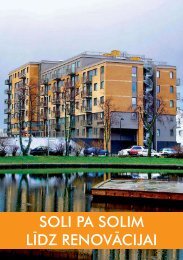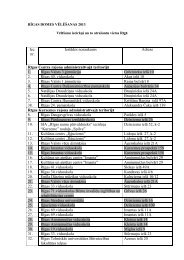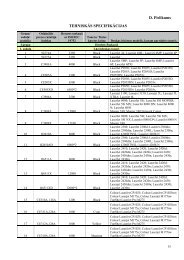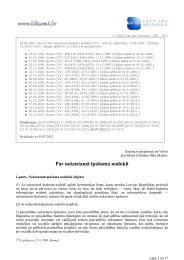Riga - European Capital of Culture 2014 candidate
Riga - European Capital of Culture 2014 candidate
Riga - European Capital of Culture 2014 candidate
- No tags were found...
You also want an ePaper? Increase the reach of your titles
YUMPU automatically turns print PDFs into web optimized ePapers that Google loves.
mobile centre in sigulda,riga’s <strong>of</strong>ficial partner city<strong>Riga</strong> and Sigulda were both first mentioned in historic texts aroundthe same time – more than eight centuries ago. Both towns werefounded on the sites <strong>of</strong> the autochthonous settlements <strong>of</strong> theFinno-Ugric Livonians. Like <strong>Riga</strong>, the hill forts <strong>of</strong> Sigulda and thecastles and fortifications that replaced them when it was a Livonianstronghold (medieval Livonia was named after the indigenousFinno-Ugric people by the conquering Germans) were later takenby diverse armed forces. Sigulda flourished in the late 19th centuryas a consequence <strong>of</strong> the construction <strong>of</strong> the <strong>Riga</strong>-Pskov roadand the <strong>Riga</strong>-Valka railway line. Grand Duke Kropotkin, the owner<strong>of</strong> a great estate there, developed Sigulda as a resort, popularin the Russian Empire, where tourists could walk the so-called‘alpine paths’, visit the castle ruins and caves, and enjoy carriagerides or bobsled runs.The wooden buildings <strong>of</strong> Sigulda, built in the style <strong>of</strong> a Swissalpine resort, were partly destroyed in the First World War. Themanor <strong>of</strong> the estate was nationalised during the agrarian reformwhen Latvia became independent, becoming a guest house forthe Union <strong>of</strong> Writers and Journalists. During the Second WorldWar, Sigulda saw the destruction <strong>of</strong> its railway station, the bridgespanning the Gauja River, and the amphitheatre. In the Soviet period,development plans resulted in the growth <strong>of</strong> industry andconstruction <strong>of</strong> apartment blocks. It became a minor regional administrative,economic and cultural centre.The Sigulda area is still nicknamed the Switzerland <strong>of</strong> Vidzeme.Efforts to preserve the environment led to the creation <strong>of</strong> Latvia’sfirst national park in the area in the 1930s; its status was renewedas the Gauja National Park. The park covers 91,745 hectares andis listed as a specially protected territory by the <strong>European</strong> “Natura2000” programme, and as a sanctuary for birds by the <strong>European</strong>Union. There are more than 500 cultural and historical places <strong>of</strong>interest within – hill forts, castles, churches, ancient estates, watermills,windmills, and other architectural, archaeological and artsites.The aerial cable car to Krimulda, opened in 1969, quickly becamea popular tourist attraction. The sledding complex, opened in1986, made Sigulda an international winter sports centre.An integral part <strong>of</strong> Sigulda’s renown is its Opera Festival. The celebration<strong>of</strong> the town’s 800 th birthday in 2006 was testimony to thefact that Sigulda is a regional centre that can attract attention notonly in the area but throughout Latvia and among foreign visitors.An open air theatre festival and the concert hall known asthe “White Grand Piano” (Baltais flīģelis) play a role in the town’spopularity as a festival venue.The Sigulda region has two principal approaches with regard tothe <strong>2014</strong> project, taking into account its place in the history <strong>of</strong>culture <strong>of</strong> this part <strong>of</strong> Europe:• producing an audit <strong>of</strong> the cultural and historical heritage thatupdates the centuries old ethical and aesthetic values <strong>of</strong> the regionin an international context;• using the skills and know-how, intertwined with local historyand the services Sigulda provides, in a manner that involves asmany local residents as possible.In preparing its proposal to participate in the <strong>Riga</strong> application tobe the <strong>European</strong> <strong>Capital</strong> <strong>of</strong> <strong>Culture</strong> in <strong>2014</strong>, Sigulda has closelyfollowed the goals and themes <strong>of</strong> the <strong>Riga</strong> proposal.140 141




